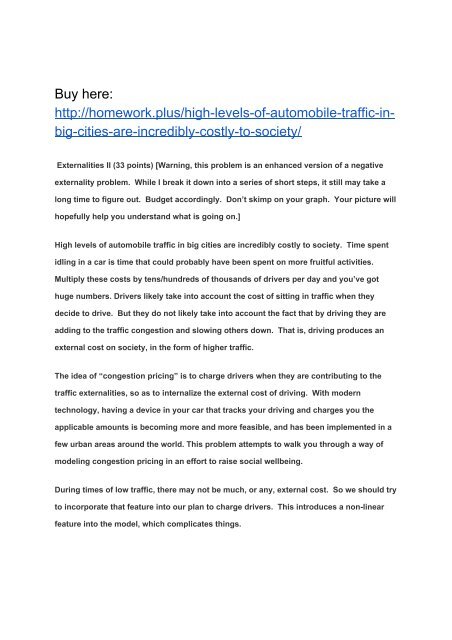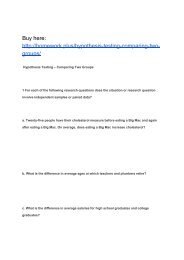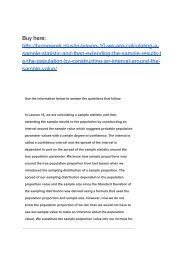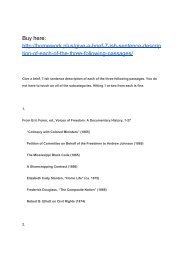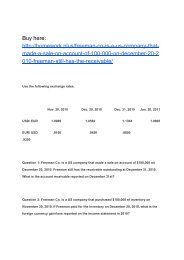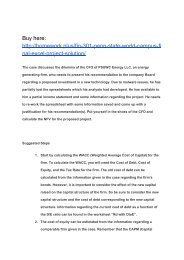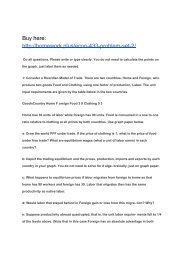High levels of automobile traffic in big cities are incredibly costly to society
High levels of automobile traffic in big cities are incredibly costly to society
High levels of automobile traffic in big cities are incredibly costly to society
Create successful ePaper yourself
Turn your PDF publications into a flip-book with our unique Google optimized e-Paper software.
Buy here:<br />
http://homework.plus/high-<strong>levels</strong>-<strong>of</strong>-<strong>au<strong>to</strong>mobile</strong>-<strong>traffic</strong>-<strong>in</strong><strong>big</strong>-<strong>cities</strong>-<strong>are</strong>-<strong>in</strong>credibly-<strong>costly</strong>-<strong>to</strong>-<strong>society</strong>/<br />
Externalities II (33 po<strong>in</strong>ts) [Warn<strong>in</strong>g, this problem is an enhanced version <strong>of</strong> a negative<br />
externality problem. While I break it down <strong>in</strong><strong>to</strong> a series <strong>of</strong> short steps, it still may take a<br />
long time <strong>to</strong> figure out. Budget accord<strong>in</strong>gly. Don’t skimp on your graph. Your picture will<br />
hopefully help you understand what is go<strong>in</strong>g on.]<br />
<strong>High</strong> <strong>levels</strong> <strong>of</strong> <strong>au<strong>to</strong>mobile</strong> <strong>traffic</strong> <strong>in</strong> <strong>big</strong> <strong>cities</strong> <strong>are</strong> <strong>in</strong>credibly <strong>costly</strong> <strong>to</strong> <strong>society</strong>. Time spent<br />
idl<strong>in</strong>g <strong>in</strong> a car is time that could probably have been spent on more fruitful activities.<br />
Multiply these costs by tens/hundreds <strong>of</strong> thousands <strong>of</strong> drivers per day and you’ve got<br />
huge numbers. Drivers likely take <strong>in</strong><strong>to</strong> account the cost <strong>of</strong> sitt<strong>in</strong>g <strong>in</strong> <strong>traffic</strong> when they<br />
decide <strong>to</strong> drive. But they do not likely take <strong>in</strong><strong>to</strong> account the fact that by driv<strong>in</strong>g they <strong>are</strong><br />
add<strong>in</strong>g <strong>to</strong> the <strong>traffic</strong> congestion and slow<strong>in</strong>g others down. That is, driv<strong>in</strong>g produces an<br />
external cost on <strong>society</strong>, <strong>in</strong> the form <strong>of</strong> higher <strong>traffic</strong>.<br />
The idea <strong>of</strong> “congestion pric<strong>in</strong>g” is <strong>to</strong> charge drivers when they <strong>are</strong> contribut<strong>in</strong>g <strong>to</strong> the<br />
<strong>traffic</strong> externalities, so as <strong>to</strong> <strong>in</strong>ternalize the external cost <strong>of</strong> driv<strong>in</strong>g. With modern<br />
technology, hav<strong>in</strong>g a device <strong>in</strong> your car that tracks your driv<strong>in</strong>g and charges you the<br />
applicable amounts is becom<strong>in</strong>g more and more feasible, and has been implemented <strong>in</strong> a<br />
few urban <strong>are</strong>as around the world. This problem attempts <strong>to</strong> walk you through a way <strong>of</strong><br />
model<strong>in</strong>g congestion pric<strong>in</strong>g <strong>in</strong> an effort <strong>to</strong> raise social wellbe<strong>in</strong>g.<br />
Dur<strong>in</strong>g times <strong>of</strong> low <strong>traffic</strong>, there may not be much, or any, external cost. So we should try<br />
<strong>to</strong> <strong>in</strong>corporate that feature <strong>in</strong><strong>to</strong> our plan <strong>to</strong> charge drivers. This <strong>in</strong>troduces a non-l<strong>in</strong>ear<br />
feature <strong>in</strong><strong>to</strong> the model, which complicates th<strong>in</strong>gs.
The “speed curve” gives the speed <strong>of</strong> <strong>traffic</strong> (S) as a function <strong>of</strong> the number <strong>of</strong> drivers (N)<br />
at a time.<br />
On certa<strong>in</strong> stretch <strong>of</strong> highway, let miles per hour when N
The benefits <strong>of</strong> driv<strong>in</strong>g changes based on the time <strong>of</strong> day. Dur<strong>in</strong>g Peak (P) times <strong>of</strong> day<br />
(morn<strong>in</strong>g or afternoon rush hour) the marg<strong>in</strong>al social benefit is higher than at Off-Peak<br />
times (O).<br />
Let MSB P =.75-(1/6000)N. Let MSB O = .5-(1/1000)N. I’ve selected these numbers so that the<br />
results work out reasonably cleanly.<br />
Calculate the socially optimal level <strong>of</strong> <strong>traffic</strong> (N*) dur<strong>in</strong>g P and O times <strong>of</strong> day. What is the<br />
value <strong>of</strong> the MSB at the optimal level dur<strong>in</strong>g these times?<br />
Hopefully you recognized <strong>in</strong> the last part that dur<strong>in</strong>g time O the socially optimal level and<br />
the market level will be the same. Dur<strong>in</strong>g time P, what will the market level <strong>of</strong> <strong>traffic</strong> be<br />
(N M )? What is the MSB at this level <strong>of</strong> <strong>traffic</strong> dur<strong>in</strong>g time P?<br />
What is the difference between the market level <strong>of</strong> <strong>traffic</strong> (N M ) and the optimal level (N*)?<br />
What is the deadweight loss per mile from <strong>to</strong>o much <strong>traffic</strong>?<br />
What should the “congestion price” be per mile dur<strong>in</strong>g time period P? (The congestion<br />
price is effectively a per unit tax that br<strong>in</strong>gs the MPC and MSC <strong>in</strong><strong>to</strong> alignment at the<br />
optimal level <strong>of</strong> <strong>traffic</strong>.)<br />
Are there any un<strong>in</strong>tended consequences possible from impos<strong>in</strong>g a congestion price<br />
dur<strong>in</strong>g peak times? (H<strong>in</strong>t: remember what substitute goods <strong>are</strong>?) Write a paragraph <strong>of</strong> at<br />
least 100 words clearly describ<strong>in</strong>g your thoughts.


